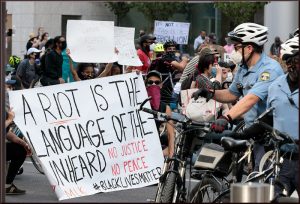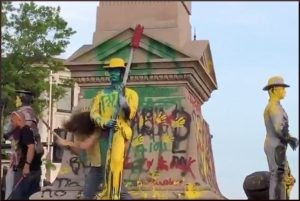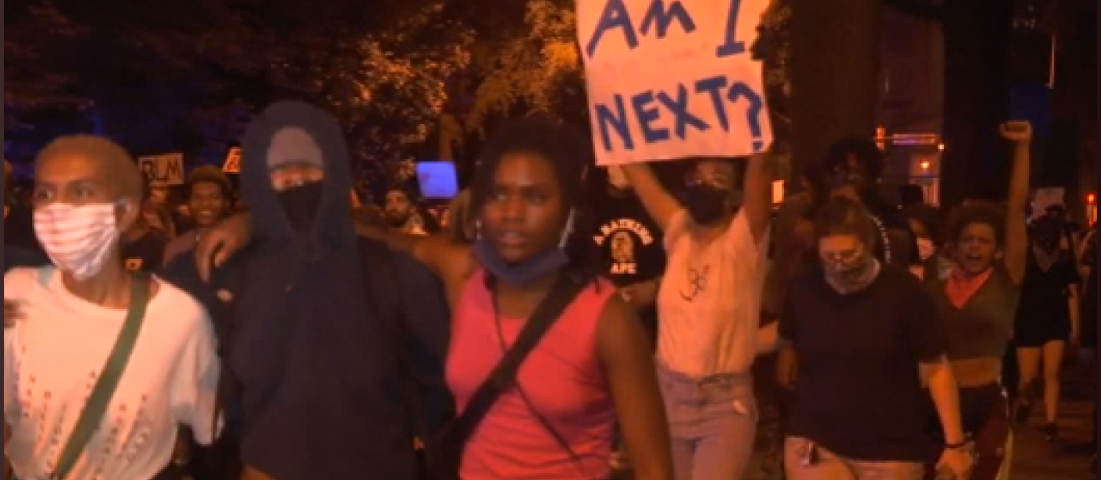Published in the Virginia Defender Newspaper, Summer 2020 Edition
The protests that erupted after the public police murder of George Floyd in Minneapolis have grown into the broadest and most sustained rebellion against racism in U.S. history.
They have not been as violent as those during the Long Hot Summer of 1967, or the uprisings in more than 100 cities after the assassination of the Rev. Martin Luther King Jr. in 1968 or the Los Angeles Rebellion after the vicious police beating of Rodney King in 1992, but they have now taken place over more than 10 weeks in more than 2,000 cities, in every state and in more than 60 countries. This includes more than a third of the 133 cities and counties here in Virginia.
The result has been a national, radical reckoning on the issues of race and police brutality that the ruling class has up till now successfully managed to either prevent or control. A recent Washington Post poll found that two-thirds of the country now believes that George Floyd’s death represents a broader problem in law enforcement – a low bar, to be sure, but a dramatic increase from how people felt about the 2014 police murder of Michael Brown in Ferguson, Mo., and it represents a fundamental shift in the views of many whites.
So where are we now? What has been won? What lessons can be learned? What did we do right, what mistakes can we learn from – and where do we go from here?
The following is meant to be a Defender contribution to that discussion.
Nature of the Protests
 First of all, it must be emphasized that this was a true rebellion: An organic, mass uprising against government authority motivated by deep and long-standing oppression. And while mostly Black-led, from the beginning this rebellion has also been very multiracial.
First of all, it must be emphasized that this was a true rebellion: An organic, mass uprising against government authority motivated by deep and long-standing oppression. And while mostly Black-led, from the beginning this rebellion has also been very multiracial.
Like all true rebellions, it has had its excesses, but that doesn’t change the fundamental fact that the Rebellion was/is legitimate and must be supported by all true progressives.
Part of that support must be demanding complete amnesty for all those facing charges as a result of their participation. We can’t allow the police and politicians to divide us into “good protesters” and “bad protesters.” This is a form of war, and in war you demand the return of all your soldiers, period.
Targets and Tactics
Property damage is usually a part of any rebellion. Think “Boston Tea Party.” The issue isn’t “peaceful” vs. “violent,” but rather a question of tactics, targets and timing.
Tagging and tearing down symbols of white supremacy are righteous acts. The Confederate statues, long protected by double-talking politicians, were an obvious target. An institution like Wells Fargo is known for a long history of corruption and racial discrimination. A GRTC Pulse bus is a symbol of gentrification. The national headquarters of the United Daughters of the Confederacy, the organization that played a key role in the development of the “Lost Cause” mythology, is an open sore on Richmond’s landscape.
On the other hand, tossing a brick through the window of a Jewish synagogue or a 120-year-old, Black-owned business shows a severe ignorance of community and global history and a deep lack of political consciousness.
Politicians who take reactionary positions should be targeted for protests, which can be done in various creative ways. But bringing a mostly white crowd after dark to the home of a Black single mother, yelling at her to come out while shining lights into her children’s bedrooms betrays a fundamental lack of understanding of race and gender, not to mention showing crass political opportunism.
As for timing, the question has to be this: Did a particular tactic move the struggle forward, or set it back? Because unless you think the masses are ready for the Final Conflict, what we’re talking about here is winning over public opinion.
 Examined this way, the property damage carried out in the first nights of the Rebellion moved things forward. It thoroughly frightened the local ruling class and its political representatives, who at least started making noises about meeting the protesters’ demands.
Examined this way, the property damage carried out in the first nights of the Rebellion moved things forward. It thoroughly frightened the local ruling class and its political representatives, who at least started making noises about meeting the protesters’ demands.
On the other hand, the more recent and much smaller actions were seen as the work of isolated activists divorced from the larger struggle, and so handed the police and elected officials a potent argument against the perpetrators and militancy as a whole.
To its credit, the Richmond Community Bail Fund supported all those arrested in all these actions.
The Role of Whites
The police, politicians and media have tried to project the Rebellion as being hijacked by young whites pursuing their own agenda over the needs of the Black community. While there have been some who seem to see chaos as a strategy, this argument ignores the fact that broad layers of white youth have their own grievances. They are facing a rapidly shrinking future beset by climate change, the current and probably future pandemics and an economic crisis due more to the approaching end days of capitalism than the failings of any individual politician or party. Add to that a heightened sense of injustice over racial and gender oppression and you have the basis for white youth going beyond sympathy for the Black community to becoming actual allies willing to put their own bodies on the line.
Fundamentally, the Rebellion is directed against racism and the police murders of Black people, and it’s correct that Black people should be in the leadership. And many in this new movement have demanded that the most marginalized voices finally be heard, particularly young Black women and trans folk. Of course, this doesn’t mean that whites should be deciding which Black voices are authentic. Real leaders emerge in times of real struggle. For now, just showing up and standing firm against the oppressors is enough.
Collective Decision Making & Demands
The largely spontaneous nature of the early days of the Rebellion had both positive and negative sides. On the one hand, spontaneity is what has made the Rebellion genuine. On the other, there has been a tendency among some activists to argue against organization and collective decision-making in general, often saying that approach is necessary for security reasons. In previous movements, such as Occupy, people would gather in open, public meetings – people’s assemblies – and discuss goals and how to achieve them. This has been happening in informal ways, but has not led to broad, democratic decision-making.
Fortunately, there already were long-standing demands that were picked up by the movement as a whole. The family of Marcus-David Peters, the young biology high school teacher fatally shot in 2018 by a Richmond police officer while experiencing a mental health crisis, had been demanding a Marcus Alert system to address situations of mental health crises; a civilian review board with subpoena power; and the reopening of the Marcus-David Peters case. Early in the Rebellion, the family, operating as Justice and Reformation, updated these demands, adding defunding the police, which was being raised by the protesters. The Defenders suggested adding amnesty for all protesters and taking down all Confederate symbols in the city. A seventh demand, that all officers charged with abuses during the Rebellion be publicly identified, was added by protesters at the Reclamation Plaza encampment at City Hall. These seven demands (see page 9) have now been accepted and promoted by the movement as a whole.
And, also on the plus side, the Rebellion has shown how the people can self-organize to provide needed services: Street medics; a community bail fund; a consortium of volunteer lawyers; free food distribution and library at the Circle; security teams; clothing repair, and more.
Contradictory Roles of the Nonprofits
While nongovernmental organizations (NGOS) addressing social problems date back to the 1800s, the creation of official nonprofit status (Section 501(c)3 of the Tax Reform Act of 1969) led to an explosion in the creation of nonprofit organizations. Today they are so prevalent that many young activists think their goal should be to get a job with a nonprofit so they can “do political work” full time.
While many of these groups do very good work, there are severe downsides. Nonprofits are funded by grantmaking foundations that dictate the groups’ permitted agendas. And since most liberal foundations are sympathetic to if not tied to the Democratic Party, a nonprofit’s agenda must align with that party’s limited economic, political and social goals. Most importantly, the nonprofits must never question U.S. foreign policy, in which the Democrats are just as guilty of crimes to humanity as are the Republicans.
Nonprofits also are fundamentally undemocratic organizations. Their directors are hired by boards, not elected by staff members, let alone the communities they purport to serve.
And the paid staff organizers are now fundamentally removed from and positioned above the targeted communities. Win or lose any struggle, they still will have a job, so long as they can convince their grant making foundations that they have been carrying out the assigned agenda – an effort that also breeds competition between nonprofits and often the exaggeration of accomplishments.
Ever since the first workers decided to organize against an oppressive boss or enslaved people planned a rebellion or escape, “activists” have lived and worked among the people they aimed to serve. They experienced the same class, racial and gender oppression. That authentic experience shaped their political consciousness. Today’s nonprofits cultivate a sense of petit-bourgeois, individualistic careerism that is far removed from revolutionary consciousness.
Role of the Democratic Party
The argument that there is no difference between the Republicans and Democratic parties falls on deaf ears in the working class and oppressed communities. Donald Trump comes as close to a fascist as any U.S. president in history. Just the thought of small children being separated from their families and left in despair in cages should be enough to oppose his re-election.
But fundamentally, both parties are funded and controlled by the same small, fabulously wealthy elite of U.S. society. Both are thoroughly committed to the defense of corporate interests and capitalism itself, at home and abroad. Because of their very nature, neither party can be an effective vehicle for fundamental social, economic or political change.
And so, faced with something like the Rebellion, Democrats – supposedly representing the working class and communities of color – understand that they have two responsibilities: Co-opt the movement and dilute it if they can, or crush it if they can’t.
In Richmond, the local Democratic Party machine has tried both tactics at the same time. Under mass pressure, Richmond’s Democratic mayor twice replaced his chief of police, but all three chiefs have directed crackdowns on protesters. Democratic politicians and the head of the Richmond Branch NAACP – who said he was not representing the Richmond Branch NAACP – held a press conference with the police at Libby Hill to denounce the protests.
But the Dems and their allies also organized the June 13 5,000-Man March to the Lee statue that included the cops and the mayor, as well as the Aug. 8 Conversations at the Monument dog-and-pony show, both of which were intended to corral and tame the Rebellion. So far, most protesters seem to have clearly seen through this dual crack-down/co-op strategy.
On the other hand, we now have the spectacle of media-anointed movement “leaders” publicly cheering the selection of California’s Top Cop as Joe “1994 Crime Bill” Biden’s running mate, simply because she is Black and a woman. This is political bankruptcy at its worst.
Role of Security
Much has been made of the fact that some of the protesters have been armed, on protests and at the Marcus-David Peters Circle. Here are a few examples of why that was felt to be necessary:
On June 7, a self-described leader of the KKK drove his truck into a group of BLM protesters just outside the city in Henrico County.
On June 12, three carloads of heavily armed white men – some carrying zip-ties – stopped by the MDP Circle. One driver drove his vehicle into a young Black man at the Circle.
On June 19, then-interim Police Chief William “Jody” Blackwell issued a “reminder” to the public that “the Richmond Police Department has the authority to declare protests that become violent, dangerous or disruptive as unlawful assemblies. … Failure to disperse will result in arrest and/or exposure to chemical agents.’”
The next day, about three dozen cops showed up at the Circle, some of them with assault rifles, some with zip-ties. People already had been on edge because several right-wing organizations had announced their intentions to come to Richmond to “defend” the Confederate statues. And, earlier in the day, an armed, off-duty Richmond International Airport police officer had been arrested for trespassing after being seen standing on the roof of a nearby building, filming the people gathered around the Lee state.
The police officers approached the Circle and stood in the street for about five minutes, not saying a word, just staring at the people inside. The officer in charge finally announced that if they moved their cars from around the Circle that the officers would leave. The cars were moved and the police gingerly walked backwards down the street to their cars, got in and drove in reverse out of the area.
Defenders at the scene were convinced the police were there to provoke an incident in order to clear the Circle, and only retreated when they saw that some in the Circle were as heavily armed as they were.
Yes, some protesters armed themselves and provided security for the others. This was necessary, justified and proper.
Reform vs. Abolition
There’s a heavy and at times acrimonious debate going on now about whether we should fight for “reform” or “abolition” of police departments.
The reformists promote changes like civilian review boards; mandatory police wearing of body cams; the Marcus Alert; “defunding” the police (which usually means taking funds the police use for non-police activities and transferring it to human services agencies), as well as demilitarizing the police, meaning relieving them of military-style equipment like tanks, grenade launchers, and tear gas, which is already banned under international law for use in combat.
On the other hand, abolitionists argue that the police are an inherently oppressive institution and should be done away with altogether and replaced with some form of less-lethal, community-based public safety system, or nothing at all.
In our view, this is a false dichotomy. Any reform that results in less bodily harm or death to the public, especially people of color, is something worth fighting for. And besides the reform itself, the struggle for the reform teaches people both how to fight and also the limitations of reforms under the present political system. Meanwhile, the oppressed communities in particular have the very real problem of street violence, which leads many people of color to support the police in a general way, while opposing their specific acts of abuse and brutality.
Our ultimate goal should be the total elimination of all means of repression in society: The cops, courts, prisons and military. The present ruling class is never going to agree to that, because those means of repression are what keep it in power. So abolition will only come with the elimination of capitalism, not before.
But fighting for reforms helps build the fighting organizations that we all need; gives us the opportunity to work through challenges like forms of organization, decision-making and leadership; and ultimately teaches us that true justice cannot be won within an unjust system.
There are many other issues we could examine, but we hope this is at least a modest contribution to an ongoing discussion.
This analysis was first published in the Summer 2020 edition of The Virginia Defender newspaper, a statewide quarterly published by the Virginia Defenders for Freedom, Justice & Equality, Phil Wilayto, Editor. The newspaper can be reached at: DefendersFJE@hotmail.com.
